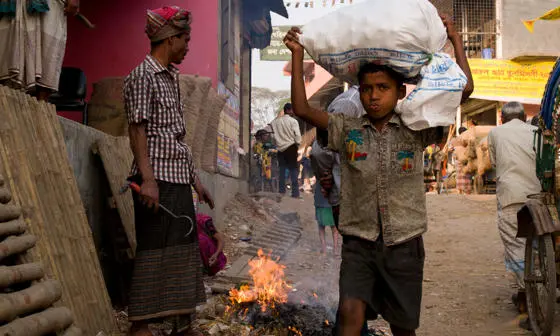Improving the lives of the ultra-poor

What was the problem?
Despite significant economic growth, extreme poverty persists. Understanding its causes and ways to address it have obvious implications for human welfare and policy design.
Economic growth and social-protection policies in emerging countries have led to a stark reduction in the share of people living in extreme poverty globally. Nevertheless, there is a fraction of the poor everywhere that does not benefit from this growth in average incomes and remains in extreme poverty. The decline in inequality between countries has been accompanied by a rise in inequality within countries, and now most of the world’s poorest people live in middle-income countries. Reaching these people is therefore a question of designing effective social policies, in addition to achieving more economic growth.
In South Asia, these extremely poor people constitute a marginalised group, typically living in remote, rural areas where they cannot access urban labour markets. They are almost all illiterate, tend to own no land or assets and work as casual labourers in agriculture or domestic services. The majority are landless rural women. Traditional poverty alleviation interventions such as food aid, cash transfers, public works programmes, and market-based interventions, including microfinance, have shown little effect for them. This group has been referred to as the "ultra-poor".
Since the 1990s, research organisations and development agencies have exerted considerable effort to understand which interventions might work here. With the adoption of the UN’s Sustainable Development Goals in 2015, the commitment to "end poverty in all its forms everywhere" was renewed, and a particular focus has been placed on implementing nationally appropriate social protection systems for the poorest by 2030.
What did we do?
International Growth Centre researchers Professor Oriana Bandiera (LSE), Professor Robin Burgess (LSE), and Professor Imran Rasul (UCL), together with colleagues from the University of Bocconi, collaborated with the international development agency BRAC to provide the first evaluation of an anti-poverty programme targeting the ultra-poor (TUP), specifically landless women, also known as a "graduation programme".
This programme by BRAC gives the women who are selected to participate a choice of income-generating assets, from which all participants selected livestock. Participants also receive a two-year support package of training and assistance in working with this livestock. The programme effectively gives ultra-poor women a substantial boost in both skills and assets with the aim of transforming their economic lives. Costing US $1,200 per beneficiary, the programme is very expensive relative to other forms of assistance, at least in the short run. It is therefore only a good investment if participants work with the assets to set up a sustainable business.
To evaluate this programme, the team ran a large-scale and long-run randomised control trial in Bangladesh covering over 21,000 households in 1,309 villages, surveyed four times (in 2007, 2009, 2011, and 2014). The evaluation was designed to detect effects across social classes, including non-recipients, for a full seven years after the programme was introduced, and to assess whether it achieved long-term changes in lifting people out of poverty.
The study found significant improvements in living standards. For example, the earnings of women in the programme were 21 per cent higher, their per capita expenditure was 11 per cent higher, and the value of durable goods they owned was 57 per cent higher, relative to the control group. Importantly, these gains persisted four years after the start of the programme and two years after it ended. Programme beneficiaries also accumulated cash savings (400 per cent increase) and productive assets, setting them up for a more stable future.
These gains are generated through an occupational change: after receiving the asset transfer and training, the poor shifted from casual wage labour into self-employed livestock rearing, working more regularly, on more days, and for longer hours. The increase in work time makes a large difference for the poorest, who were previously severely under-employed.
The study also provides general insights about the nature of poverty, namely that the very poorest are neither unwilling nor unfit to engage in the same jobs as more prosperous women in their communities, but face barriers to accessing stable and productive work. This bears an important lesson for social policy, which has traditionally focused on propping up consumption of the poor with regular transfers. Such consumption support policies are too small to transform the occupational options available to the poor. Large programmes like this one, on the other hand, can make a permanent difference to how the poor generate their income, even if only done once. Consequently, such "big-push" interventions, even if expensive initially, might be more cost-effective in the long run.
What happened?
Today, graduation-style anti-poverty programmes help some three million ultra-poor households globally. Many governments and NGOs have invested in these programmes, based on the robust evidence provided by professors Bandiera and Burgess and colleagues’ research.
Most directly, the research has shaped the work of BRAC, which spends US $20 to 30 million each year on its ultra-poor graduation programme. In Bangladesh, BRAC graduated 1.9 million ultra-poor households between 2002 and 2017. In line with the results of the original research, consumption, savings, and asset holdings increased dramatically among participants. BRAC has since reproduced the model in many places, with pilots in 10 other countries. The research is used in BRAC’s international advocacy work, including to help secure funds for new programmes and to demonstrate resources are spent effectively.
BRAC also uses the research to provide technical assistance for other organisations implementing graduation-style programmes, advising governments, humanitarian and development organisations, and UN bodies. Other anti-poverty organisations who have adopted a graduation approach include: World Vision International, and its work improving the lives of vulnerable children; Haitian NGO Fonkoze, which has graduated more than 6,000 Haitian women out of ultra-poverty; the BOMA Project, a collaboration between a US non-profit organisation and Kenyan NGO which helps women in extreme poverty in Kenya; and international development agency Trickle Up, which has piloted adaptations of the BRAC graduation programme to improve the lives of indigenous people and people with disabilities.
The United Nations High Commissioner for Refugees (UNHCR), which serves 33.9 million displaced people globally, has adapted the BRAC’s programme to support its work with refugees. National governments, including in Kenya, the Philippines, and Pakistan, have also incorporated the graduation approach into their social protection and poverty alleviation policies.
In total, according to the World Bank’s Partnership for Economic Inclusion, in 2018, 99 graduation programmes served 3.1 million households in 43 countries. According to BRAC, by 2020 the graduation approach had been adopted by 114 programmes in 45 countries. The original research continues to inform these programmes, affecting the strategic spending of millions of dollars, and ultimately helping millions of the world’s poorest people achieve stable and sustainable futures.


